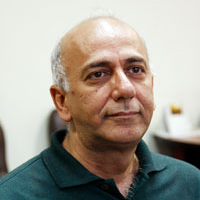Western Music in Iran at Qajar Era
Author(s):
Abstract:
The western music، unlike the western painting which began to influence the Iranian culture since the Safavid era، has only recently، at Qajar period، introduced in Iran. In addition، its introduction was done in a totally indirect way through the modernization of the army by the prince Abbas Mirza، at the very beginning of the period in question. In fact، in order to complete this modernization، Abbas Mirza formed a western-style military band، and so، for the first time، the Iranians began to learn، in an official and formal way، a few tunes and also some instruments of western music. Yet، it was only at the time of Naser-ed-Din Shah that this contact with western music takes considerable dimensions. At this time، a French officer، Alfred Jean-Baptiste Lemaire، enter Iran and began، under the order of the Qajar sovereign، to form several military bands and to teach in a systematic way the western music at a prestigious school، Dar-ol-Fonun، where was taught all kind of scientific matters by mostly European teachers. Thus، after a timid appearance under the reign of two former kings، who probably had introduced very limited number of western instruments، the western music at the time of Naser-ed-Din Shah، began to spread in a radical way. Yet، it is important to know that not only in this time، but even throughout theQajar era، western music did not able to have a great influence on Iranian music andmusical culture. It has been very different with the western painting which had influenced the Iranian aesthetics from the beginning of its appearance in Iran، in such a way that some great painters of the Safavid era adopted the western techniques very soonand created a new current of painting named «farangisâzi» (westernization) which combined these techniques with some elements of the traditional style. At the Qajar era، this style reached its apogee، so that it totally abandoned the remaining traditional elements and traits، and adopted completely the western style. Western music at the Qajar era not only did not replace the traditional music، but there is even no evidence، at this time، of a sort of musical hybridization comparable to the farangisâziof the last Safavid painting. We can say only that it coexists with the traditional music as a «second music» of Iranian culture. Even when the Iranian musicians begin to prefer certain instruments of western music، like the piano، the violin، the clarinet and the flute، they normally use them for playing the Iranian music. For an important influence of western music on the musical aesthetics of the country and a radical conflict between the supporters of the tradition and those of modernity and westernized music one must wait until the Phalavi era. We cannot say، however، that the western music has had no influence on the Iranian culture at the Qajar era، but we must seek this influence، not so much in the music itself but rather in the musical conceptions and behaviors.
Keywords:
Language:
Persian
Published:
Honar-Ha-Ye-Ziba: Honar-Ha-Ye Mosighi Va Namayeshi, Volume:19 Issue: 50, 2014
Pages:
5 to 16
magiran.com/p1319667
دانلود و مطالعه متن این مقاله با یکی از روشهای زیر امکان پذیر است:
اشتراک شخصی
با عضویت و پرداخت آنلاین حق اشتراک یکساله به مبلغ 1,390,000ريال میتوانید 70 عنوان مطلب دانلود کنید!
اشتراک سازمانی
به کتابخانه دانشگاه یا محل کار خود پیشنهاد کنید تا اشتراک سازمانی این پایگاه را برای دسترسی نامحدود همه کاربران به متن مطالب تهیه نمایند!
توجه!
- حق عضویت دریافتی صرف حمایت از نشریات عضو و نگهداری، تکمیل و توسعه مگیران میشود.
- پرداخت حق اشتراک و دانلود مقالات اجازه بازنشر آن در سایر رسانههای چاپی و دیجیتال را به کاربر نمیدهد.
In order to view content subscription is required
Personal subscription
Subscribe magiran.com for 70 € euros via PayPal and download 70 articles during a year.
Organization subscription
Please contact us to subscribe your university or library for unlimited access!



